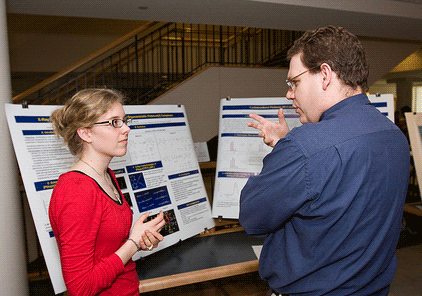Faculty Advisor
James Wollack and Alexandra Jones
Department
Chemistry
Abstract
Since every chemical has some level of toxicity associated with it, no chemical reaction is totally green. Declaring a chemical reaction is green can only be done when comparing one reaction to another reaction. To do this every aspect of both reactions must be accessed. This includes comparing cost, yield, environmental impacts of the starting materials and products, and energy requirements. Often organic chemistry labs focus solely on techniques which leaves the students lost in regards to what they are actually doing in terms of the impact of their work on scientific advancement and environmental deterioration. The goal of this project is to get students to access the impacts of all components of two chemical reactions that yield the same product. Students will choose two procedures using the journal database SciFinder Scholar and attempt their completion in lab. Before beginning the reactions the students will access the “greenness” of both reactions using a metrics based point system. Then the students will complete both reactions looking at cost, time, and environmental impact in order to determine which reaction is more green. The goal is to get students to think more concretely about what they actually are doing in lab by looking more in depth at each chemical, product, and byproduct. Students will also become more aware about the environmental and cost impact of scientific research. In order for a reaction to be green it also must be cost effective otherwise no one will do it. A lab will also be introduced into general chemistry that includes an introduction of the 12 principals of green chemistry and a revamping of an old lab to make it more green. Introducing green chemistry at introductory levels will increase the future impact of the green chemistry project completed in organic chemistry.
Funding source, if applicable
Minnesota Pollution Control
Start Date
19-4-2012 11:00 AM
End Date
19-4-2012 1:00 PM
Green Chemistry Metrics for Choosing a Reaction: Incorporation of Independent Green Chemistry Student Assessments in Organic Chemistry Lab.
Since every chemical has some level of toxicity associated with it, no chemical reaction is totally green. Declaring a chemical reaction is green can only be done when comparing one reaction to another reaction. To do this every aspect of both reactions must be accessed. This includes comparing cost, yield, environmental impacts of the starting materials and products, and energy requirements. Often organic chemistry labs focus solely on techniques which leaves the students lost in regards to what they are actually doing in terms of the impact of their work on scientific advancement and environmental deterioration. The goal of this project is to get students to access the impacts of all components of two chemical reactions that yield the same product. Students will choose two procedures using the journal database SciFinder Scholar and attempt their completion in lab. Before beginning the reactions the students will access the “greenness” of both reactions using a metrics based point system. Then the students will complete both reactions looking at cost, time, and environmental impact in order to determine which reaction is more green. The goal is to get students to think more concretely about what they actually are doing in lab by looking more in depth at each chemical, product, and byproduct. Students will also become more aware about the environmental and cost impact of scientific research. In order for a reaction to be green it also must be cost effective otherwise no one will do it. A lab will also be introduced into general chemistry that includes an introduction of the 12 principals of green chemistry and a revamping of an old lab to make it more green. Introducing green chemistry at introductory levels will increase the future impact of the green chemistry project completed in organic chemistry.

